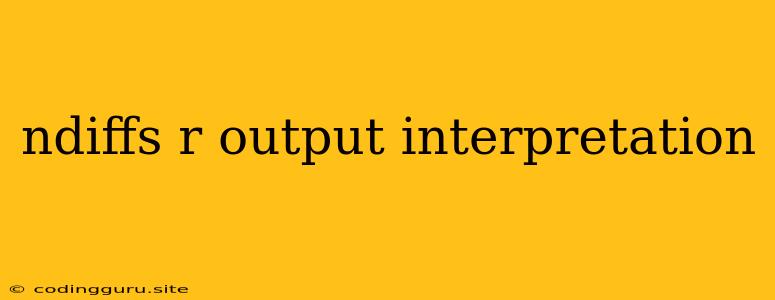Understanding the ndiffs Output: A Comprehensive Guide
The ndiffs function in statistical software packages like R plays a crucial role in time series analysis, helping us identify the order of integration of a given time series. This information is essential for building accurate models and making sound predictions. But interpreting the output of ndiffs can be tricky for beginners.
What is ndiffs?
In essence, ndiffs is a function that calculates the number of differences needed to make a time series stationary. A stationary time series is one that does not exhibit trends or seasonality, which is a prerequisite for many time series models.
Why is Stationarity Important?
- Predictability: Stationary time series are easier to predict because their statistical properties (mean, variance) remain constant over time.
- Model Accuracy: Many popular time series models, such as ARIMA, require stationary data for optimal performance.
Interpreting ndiffs Output
The ndiffs function in R returns a single value, representing the minimum number of differences required to achieve stationarity.
Example:
# Load the package
library(forecast)
# Load your time series data
data <- your_time_series_data
# Apply ndiffs
ndiffs(data)
# Output: 1
In this case, the ndiffs output is 1, indicating that the time series needs to be differenced once to achieve stationarity.
What if ndiffs Returns 0?
If ndiffs returns 0, it suggests that your time series is already stationary and does not require differencing.
What if ndiffs Returns a Negative Value?
A negative value for ndiffs is an error. It indicates that the time series might be over-differenced, meaning it's been differenced more times than necessary. This can lead to inaccurate results and predictions.
Tips for Using ndiffs Effectively
- Visual Inspection: Always plot your time series data first to get an idea of its behavior. This can help you understand whether differencing is required and how many times.
- ACF and PACF: Analyze the autocorrelation function (ACF) and partial autocorrelation function (PACF) of your time series. A stationary time series will have ACF and PACF that decay rapidly to zero.
- Experiment: If you're unsure about the
ndiffsoutput, try differencing the time series multiple times and compare the results.
Conclusion
The ndiffs function is a powerful tool for identifying the order of integration of a time series. By understanding the output and its implications, you can build more accurate and reliable time series models. Remember to use ndiffs in conjunction with other time series analysis techniques for a complete understanding of your data.
